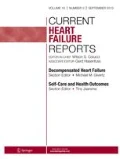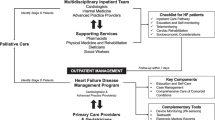Abstract
Purpose of Review
To determine the current evidence supporting the otherwise proven heart failure management programs (HFMPs) in the setting of an increasingly older and more complex patient population.
Recent Findings
Attempts to replace proven face-to-face, multidisciplinary management of HF with remote management techniques (including telemedicine and implantable remote monitoring devices) have yielded mixed results. This may well reflect the clinical cascade effect of greater surveillance paradoxically leading to worse health outcomes as well as a narrow focus on HF alone in patients with clinically significant multimorbidity. Concurrently, there is preliminary evidence that the increasing phenomenon of HF and multimorbidity in older patients is undermining the otherwise positive impact of “traditional” HFMPs.
Summary
A more nuanced approach to determining who would benefit from what form of HF management, including the integration of remote surveillance techniques, is required.

Similar content being viewed by others
References
Papers of particular interest, published recently, have been highlighted as: • Of importance •• Of major importance
Stewart S, MacIntyre K, Capewell S, McMurray J. Heart failure and the aging population: an increasing burden in the 21st century? Heart. 2003;89(1):49–53.
Benjamin EJ, Blaha MJ, Chiuve SE, Cushman M, Das SR, Deo R, et al. Heart disease and stroke statistics-2017 update: a report from the American Heart Association. Circulation. 2017;135(10):e146–603.
Heidenreich PA, Albert NM, Allen LA, Bluemke DA, Butler J, Fonarow GC, et al. Forecasting the impact of heart failure in the United States: a policy statement from the American Heart Association. Circ Heart Fail. 2013;6(3):606–19.
Shafie AA, Tan YP, Ng CH. Systematic review of economic burden of heart failure. Heart Fail Rev. 2018;23(1):131–45.
Stewart S, Riegel B, Boyd C, Ahamed Y, Thompson DR, Burrell LM, et al. Establishing a pragmatic framework to optimise health outcomes in heart failure and multimorbidity (ARISE-HF): a multidisciplinary position statement. Int J Cardiol. 2016;212:1–10.
Chen L, Chan YK, Busija L, Norekval TM, Riegel B, Stewart S. Malignant and benign phenotypes of multimorbidity in heart failure: implications for clinical practice. J Cardiovasc Nurs. 2018:1.
Tisminetzky M, Gurwitz JH, Fan D, Reynolds K, Smith DH, Magid DJ, et al. Multimorbidity burden and adverse outcomes in a community-based cohort of adults with heart failure. J Am Geriatr Soc. 2018;66(12):2305–13.
Fitch K, Lau J, Engel T, Medicis JJ, Mohr JF, Weintraub WS. The cost impact to Medicare of shifting treatment of worsening heart failure from inpatient to outpatient management settings. Clinicoecon Outcomes Res. 2018;10:855–63.
Storrow AB, Jenkins CA, Self WH, Alexander PT, Barrett TW, Han JH, et al. The burden of acute heart failure on U.S. emergency departments. JACC Heart Fail. 2014;2(3):269–77.
Ponikowski P, et al. 2016 ESC guidelines for the diagnosis and treatment of acute and chronic heart failure. Rev Esp Cardiol (Engl Ed). 2016;69(12):1167.
McAlister FA, et al. Multidisciplinary strategies for the management of heart failure patients at high risk for admission: a systematic review of randomized trials. J Am Coll Cardiol. 2004;44(4):810–9.
Rich MW, Beckham V, Wittenberg C, Leven CL, Freedland KE, Carney RM. A multidisciplinary intervention to prevent the readmission of elderly patients with congestive heart failure. N Engl J Med. 1995;333(18):1190–5.
Stewart S, Marley JE, Horowitz JD. Effects of a multidisciplinary, home-based intervention on unplanned readmissions and survival among patients with chronic congestive heart failure: a randomised controlled study. Lancet. 1999;354(9184):1077–83.
Blue L, Lang E, McMurray JJV, Davie AP, McDonagh TA, Murdoch DR, et al. Randomised controlled trial of specialist nurse intervention in heart failure. BMJ. 2001;323(7315):715–8.
Inglis SC, Clark RA, McAlister F, Stewart S, Cleland JG. Which components of heart failure programmes are effective? A systematic review and meta-analysis of the outcomes of structured telephone support or telemonitoring as the primary component of chronic heart failure management in 8323 patients: abridged Cochrane review. Eur J Heart Fail. 2011;13(9):1028–40.
McDonald K, Troughton R, Dahlström U, Dargie H, Krum H, van der Meer P, et al. Daily home BNP monitoring in heart failure for prediction of impending clinical deterioration: results from the HOME HF study. Eur J Heart Fail. 2018;20(3):474–80.
Dierckx R, Inglis SC, Clark RA, Prieto-Merino D, Cleland JGF. Telemedicine in heart failure: new insights from the Cochrane meta-analyses. Eur J Heart Fail. 2017;19(3):304–6.
Chaudhry SI, Barton B, Mattera J, Spertus J, Krumholz HM. Randomized trial of telemonitoring to improve heart failure outcomes (Tele-HF): study design. J Card Fail. 2007;13(9):709–14.
Koehler F, Winkler S, Schieber M, Sechtem U, Stangl K, Böhm M, et al. Telemedical Interventional Monitoring in Heart Failure (TIM-HF), a randomized, controlled intervention trial investigating the impact of telemedicine on mortality in ambulatory patients with heart failure: study design. Eur J Heart Fail. 2010;12(12):1354–62.
Boyne JJ, di van Asselt A, Gorgels APM, Steuten LMG, de Weerd G, Kragten J, et al. Cost-effectiveness analysis of telemonitoring versus usual care in patients with heart failure: the TEHAF-study. J Telemed Telecare. 2013;19(5):242–8.
Tse G, Chan C, Gong M, Meng L, Zhang J, Su XL, et al. Telemonitoring and hemodynamic monitoring to reduce hospitalization rates in heart failure: a systematic review and meta-analysis of randomized controlled trials and real-world studies. J Geriatr Cardiol. 2018;15(4):298–309.
Bourge RC, Abraham WT, Adamson PB, Aaron MF, Aranda JM Jr, Magalski A, et al. Randomized controlled trial of an implantable continuous hemodynamic monitor in patients with advanced heart failure: the COMPASS-HF study. J Am Coll Cardiol. 2008;51(11):1073–9.
Ritzema J, Troughton R, Melton I, Crozier I, Doughty R, Krum H, et al. Physician-directed patient self-management of left atrial pressure in advanced chronic heart failure. Circulation. 2010;121(9):1086–95.
Abraham WT, Adamson PB, Bourge RC, Aaron MF, Costanzo MR, Stevenson LW, et al. Wireless pulmonary artery haemodynamic monitoring in chronic heart failure: a randomised controlled trial. Lancet. 2011;377(9766):658–66.
• Feldman T, et al. Transcatheter Interatrial Shunt Device for the Treatment of Heart Failure With Preserved Ejection Fraction (REDUCE LAP-HF I [Reduce Elevated Left Atrial Pressure in Patients With Heart Failure]): A Phase 2, Randomized, Sham-Controlled Trial. Circulation. 2018;137(4):364–75. This phase II randomised trial of a transcatheter interatrial shunt device implanted in 22 of 44 patients with heart failure with preserved ejection fraction is representative of a new generation of more invasive devices (often with monitoring capacity) to directly improve cardiac function. The challenge for all these devices (with monitoring capacity or not) is to improve HF management beyond a small niche of predominantly younger patients with access to high-cost treatments.
Tromp J, Tay WT, Ouwerkerk W, Teng TK, Yap J, MacDonald M, et al. Multimorbidity in patients with heart failure from 11 Asian regions: a prospective cohort study using the ASIAN-HF registry. PLoS Med. 2018;15(3):e1002541.
Stewart S, Carrington MJ, Marwick TH, Davidson PM, Macdonald P, Horowitz JD, et al. Impact of home versus clinic-based management of chronic heart failure: the WHICH? (Which heart failure intervention is most cost-effective & consumer friendly in reducing hospital care) multicenter, randomized trial. J Am Coll Cardiol. 2012;60(14):1239–48.
• Scuffham PA, et al. Standard vs. intensified management of heart failure to reduce healthcare costs: results of a multicentre, randomized controlled trial. Eur Heart J. 2017;38(30):2340–8. This comparative multicentre trial represents a new generation of heart failure management trials seeking to determine what components of care are most cost-effective. Ultimately, a theoretically more cost-effective means of intensifying care (involving components of BNP-monitoring, tele-management to supplement a home-based model of care) in high-risk patients was found to be no less cost-effective than standard home-based management.
Carrington MJ, Kok S, Jansen K, Stewart S. The Green, Amber, Red Delineation of Risk and Need (GARDIAN) management system: a pragmatic approach to optimizing heart health from primary prevention to chronic disease management. Eur J Cardiovasc Nurs. 2013;12(4):337–45.
Mold JW, Stein HF. The cascade effect in the clinical care of patients. N Engl J Med. 1986;314(8):512–4.
Wiley JF, Chan YK, Ahamed Y, Ball J, Carrington MJ, Riegel B, et al. Multimorbidity and the risk of all-cause 30-day readmission in the setting of multidisciplinary management of chronic heart failure: a retrospective analysis of 830 hospitalized patients in Australia. J Cardiovasc Nurs. 2018;33(5):437–45.
Damman K, Jaarsma T, Voors AA, Navis G, Hillege HL, van Veldhuisen DJ, et al. Both in- and out-hospital worsening of renal function predict outcome in patients with heart failure: results from the coordinating study evaluating outcome of advising and counseling in heart failure (COACH). Eur J Heart Fail. 2009;11(9):847–54.
Stewart S, Wiley JF, Ball J, Chan YK, Ahamed Y, Thompson DR, et al. Impact of nurse-led, multidisciplinary home-based intervention on event-free survival across the Spectrum of chronic heart disease: composite analysis of health outcomes in 1226 patients from 3 randomized trials. Circulation. 2016;133(19):1867–77.
•• Wadhera RK, et al. Association of the hospital readmissions reduction program with mortality among Medicare beneficiaries hospitalized for heart failure, acute myocardial infarction, and pneumonia. JAMA. 2018;320(24):2542–52. This pivotal report from the USA is a timely reminder of the extensive “real world” population of heart failure patients who are invariably older and have multimorbidity. The cost-benefits of applying more invasive devices remain problematic in such a patient population. Moreover, these data highlight that hospital avoidance programs with short-term objectives (e.g. reduce 30-day readmissions) can be counter-productive and even result in harm; in this case, a strong signal of increased mortality was found.
McLennan SN, Pearson SA, Cameron J, Stewart S. Prognostic importance of cognitive impairment in chronic heart failure patients: does specialist management make a difference? Eur J Heart Fail. 2006;8(5):494–501.
Ball J, Løchen ML, Carrington MJ, Wiley JF, Stewart S. Mild cognitive impairment impacts health outcomes of patients with atrial fibrillation undergoing a disease management intervention. Open Heart. 2018;5(1):e000755.
Campbell RT, Petrie MC, Jackson CE, Jhund PS, Wright A, Gardner RS, et al. Which patients with heart failure should receive specialist palliative care? Eur J Heart Fail. 2018;20(9):1338–47.
Author information
Authors and Affiliations
Corresponding author
Ethics declarations
Conflict of Interest
The author declares that he has no conflicts of interest.
Human and Animal Rights and Informed Consent
This article does not contain any studies with human or animal subjects performed by any of the authors.
Additional information
Publisher’s Note
Springer Nature remains neutral with regard to jurisdictional claims in published maps and institutional affiliations.
This article is part of the Topical Collection on Implementation
Rights and permissions
About this article
Cite this article
Stewart, S. Have Traditional Heart Failure Management Programs Reached Their “Use by” Date? Time to Apply More Nuanced Care. Curr Heart Fail Rep 16, 75–80 (2019). https://doi.org/10.1007/s11897-019-00426-1
Published:
Issue Date:
DOI: https://doi.org/10.1007/s11897-019-00426-1




